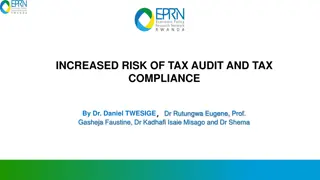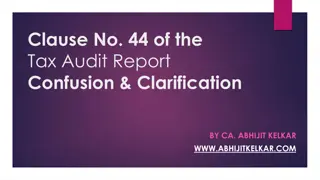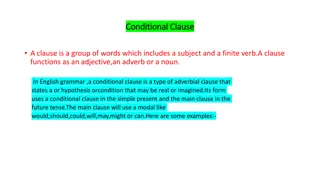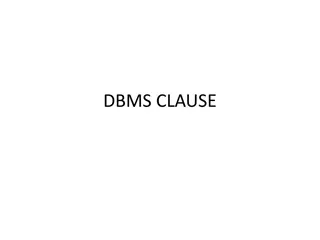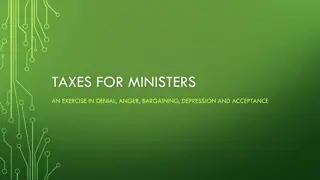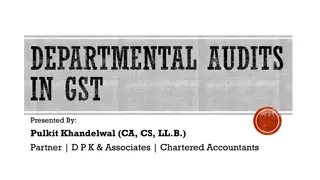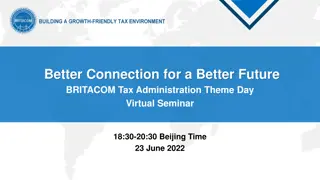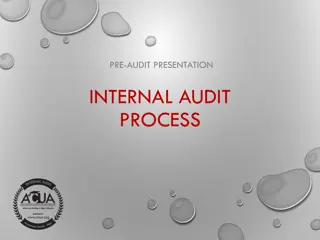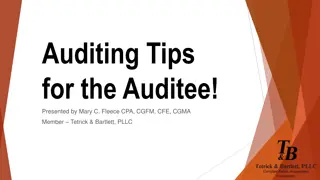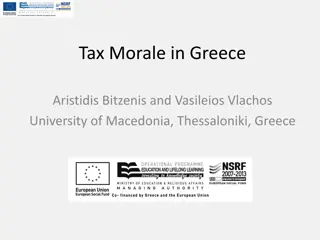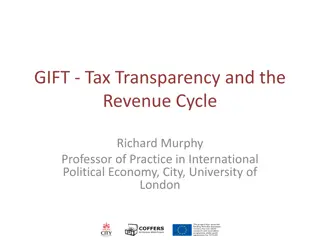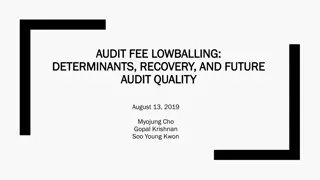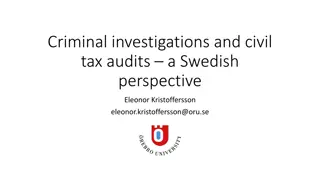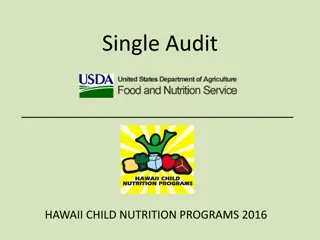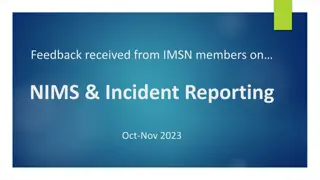Understanding the Need for Reporting Under Clause 44 in Tax Audit
Analysis of Clause 44 under Tax Audit, discussing modifications in Form 3CD, the optional reconciliation of expenses, challenges in database reconciliation, implications for assessees, and the importance of providing accurate information to align with GST regulations.
Download Presentation

Please find below an Image/Link to download the presentation.
The content on the website is provided AS IS for your information and personal use only. It may not be sold, licensed, or shared on other websites without obtaining consent from the author. Download presentation by click this link. If you encounter any issues during the download, it is possible that the publisher has removed the file from their server.
E N D
Presentation Transcript
A Critical analysis of Reporting under Clause 44 AY 2023-24 Tax Audit M. B. Abhyankar & Co. Chartered Accountants
Need for such a report under tax audit Modifications in the Tax Audit Report(Form 3CD) are generally not introduced in the Budget but directly through a notification during the year, so no Memorandum is available that explains the need / relevance / importance of this clause. There is no clarification from the Income Tax Department regarding the purpose or the end use of information sought. Clause 44 was notified vide CBDT Notification 33/2018 dated 20th August 2018 to be implemented for FY 2017-18 and onwards. Its implementation was deferred till AY 21-22 vide circular 05/2021 dated 25th March 2021. 2 www..mbabhyankar.org
Need for such a report under tax audit Reconciliation of expense-wise break up of ITC in Table 14 of GSTR 9C is kept optional for FY 2021-22 and the same is also kept optional for FY 2022-23. (GST Law is deferring the requirement but it is being sought by Income Tax Law) Problem with Clause 44 is that it is using different sets of databases, reconciliation between which is very very difficult. GST uses sale and purchase registers as basis of compilation whereas P & L Account where expenses are mainly recorded follows accounting principles of income recognition and matching of revenue with expenditure. Clauses of Tax Audit Report are to be prepared based on your financial statements not based on their reflection on GST Portal. GSTIN State based PAN country based. Inter unit transfers are reported under GST but not reflected in P& L Account disclosure in Clause 44 will be applicable to all the assessees who are subjected to tax audit u/s 44AB irrespective of the fact whether they are registered under GST or not. 3 www..mbabhyankar.org
Need for such a report under tax audit In AIS, party wise breakup of B2B purchases as per 2A/2B is available and its summary is available in TIS. This can be used as reference point. If department plans to pick up cases for scrutiny or using it as GST intelligence, then care may be taken to broadly check amounts reported under clause 44 with TIS. The rationale behind asking such information needs to be understood, as the figures reported under this Column no.5 (Purchases from other registered entities) of this clause shall serve as tool by the Income Tax Department to cross check the said figure with the figures appearing in TIS/AIS generated under GST Purchases (B2B Purchases) based on the information shared by the GSTN portal with Income Tax Department. 4 www..mbabhyankar.org
Need for such a report under tax audit Further the figures to be reported under Column no. 7 (Expenditure relating to entities not registered under GST)i.e Purchases from unregistered dealers needs to reviewed and evidence / documentation in support of such purchases should be scrutinized as the Department may ask for documentary evidence / third party confirmations for allowing such expenditure being in the nature of unregistered purchases in case of huge / extraordinary expenses reported under the said column no.7 as URD purchases. From a close look at the form 3CD contents, one would notice that it asks for specific information starting from clause 12 onwards until clause 43. For instance clause 12 seeks to know whether any part of the profit represent income qualifying for presumptive taxation. However clause 44 is drafted to gather very general and non- specific information which does not have any direct relation with income computation. 5 www..mbabhyankar.org
Reporting Table under Clause 44 incurred during the year Sr No. Total amount of Expenditure Expenditure in respect of entities registered under GST Expenditure relating to entities not registered under GST Relating to goods or services exempt from GST Relating to entities falling under composition scheme Relating to other registered entities Total payment to registered entities 1 2 3 4 5 6 = (3+4+5) 7 All head of Expenses reported in P&L Account A. B. C. Exempt. Nil rated Non- Taxable Taxpayers reg u/s 10 of CGST Act B2B Purchases To be reconciled with AIS/TIS Report to the best possible manner Purchases from Suppliers not registered under GST Non-GST Pure transactions in Money Financial Cost by Interest charged by Banks Raw Material Those paying GST without collection from Recipient A. Revenue Expenses Direct Expenses Difference may arise on account of date of invoice and reporting of invoice by the supplier after due date of filing of GSTR-1 / IFF Returns Not to be Reported in (Col.3 / 4 / 5 / 7) Indirect Expenses And not issuing any Tax Invoice a. Employee Cost Capital Expenses b. Provisions Test Check Registration status of high value suppliers from GST portal based on PAN 6 c. Depreciation B. Capital
Need for such a report under tax audit The reporting under clause 44 of Form 3CD was kept in abeyance till 31.03. 2022. It has now become mandatory for all the reports submitted after 31.03.2022. In order to verify the details filled in, the tax auditor needs to obtain from the assessee the required details in the below tabular format (an illustrative format which may be modified by the Tax auditor according to the facts and circumstances). The Tax auditor should verify the details furnished with the underlying document on a test check basis and retain the same as part of his working papers. Column No. 2 : Total amount of expenditure incurred during the year On this, the guidance note issued by ICAI provides that head-wise / nature- wise expenditure details are not envisaged in this clause. Further, the guidance material states that the amount which is not in the nature of expenses shall not be quoted in Column 3 to 7. For Example: depreciation, provision for expenses, etc. 7 www..mbabhyankar.org
Need for such a report under tax audit With the introduction of GST, the goods and services have been classified into Nil Rated, Exempted, Zero Rated and Non-GST supplies. Let us take a look at what distinguishes each of them. Nil Rated This type of supply attracts a GST of 0%. Input tax credit cannot be claimed on such supplies. Some items which are nil rated include grains, salt, jaggery, etc. Exempted This supply includes items which are used for everyday purposes. Since they are basic essentials, they do not attract any GST at all. You will not be able to claim any ITC on such supplies. Some examples include bread, fresh fruits, milk, curd, etc. 8 www..mbabhyankar.org
Need for such a report under tax audit Zero-Rated Supplies made overseas and to Special Economic Zones (SEZs) or SEZ Developers come under the zero-rated supplies. This supply attracts a GST of 0%. For such supplies, ITC can be claimed. Non-Taxable non-taxable supply" means a supply of goods or services or both which is not leviable to tax under this Act or under the Integrated Goods and Services Tax Act Supplies which don t come under the scope of the GST are termed as Non-GST supplies. However, these supplies can attract taxes other than the GST as per the jurisdiction of the state or the country. Some examples of such supplies include petrol, alcohol, etc. Non-GST Further, the transactions referred to in Schedule III to the CGST Act, 2017 are neither treated as supply of goods nor supply of services. Hence, the value of supplies specified in Schedule III (e.g. salary to employees, sale of land etc.), if any, need not be included in the value of exempt supply. 9 www..mbabhyankar.org
Critical Points for reporting under Clause 44 1) The Assessees may receive notices for Scrutiny / Comprehensive assessment, where the amount of mismatch or difference in the amounts under Col. 5 and TIS is huge or beyond tolerable limits as per the specified limits set by the Income Tax Department. 2) If amount reported under the row for revenue expenditure under Col 7 is significant in relation to Gross Receipts of business, such a high percentage of purchases from unorganised sector may invite scrutiny from both Income Tax and GST authorities. Checking of genuineness of such purchases may be considered to be necessary and precautions during tax audit on this aspect may save taxpayer and auditor from further proving of the case. www..mbabhyankar.org 10



